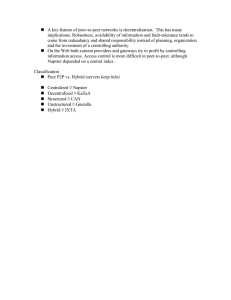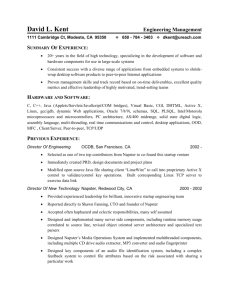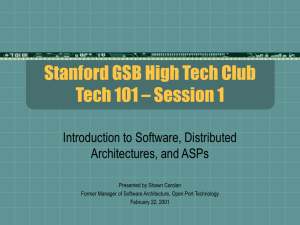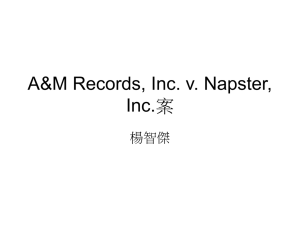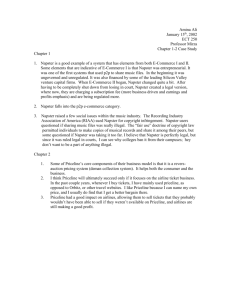Brief Amicus Curiae of Copyright Law Professors
advertisement
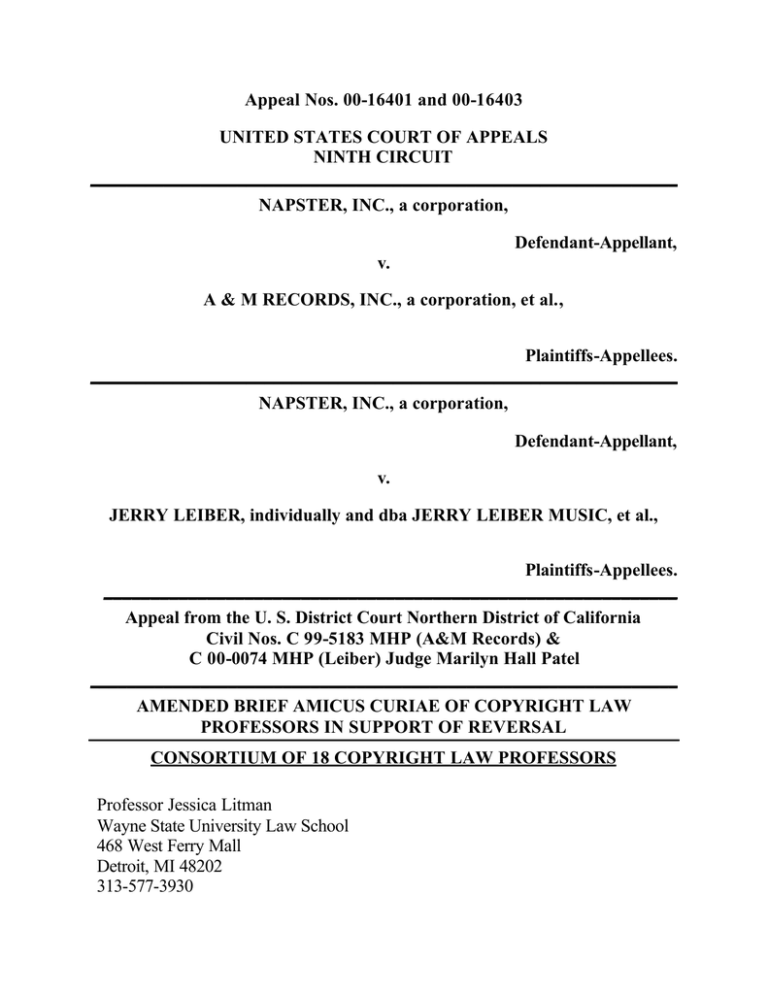
Appeal Nos. 00-16401 and 00-16403 UNITED STATES COURT OF APPEALS NINTH CIRCUIT ________________________________________________________________ NAPSTER, INC., a corporation, Defendant-Appellant, v. A & M RECORDS, INC., a corporation, et al., Plaintiffs-Appellees. ________________________________________________________________ NAPSTER, INC., a corporation, Defendant-Appellant, v. JERRY LEIBER, individually and dba JERRY LEIBER MUSIC, et al., Plaintiffs-Appellees. _____________________________________________________________ Appeal from the U. S. District Court Northern District of California Civil Nos. C 99-5183 MHP (A&M Records) & C 00-0074 MHP (Leiber) Judge Marilyn Hall Patel ________________________________________________________________ AMENDED BRIEF AMICUS CURIAE OF COPYRIGHT LAW PROFESSORS IN SUPPORT OF REVERSAL CONSORTIUM OF 18 COPYRIGHT LAW PROFESSORS Professor Jessica Litman Wayne State University Law School 468 West Ferry Mall Detroit, MI 48202 313-577-3930 Professor Keith Aoki University of Oregon School of Law 1515 Agate Eugene, OR 97403 541-346-3673 Professor Ann Bartow University of South Carolina School of Law Main & Greene Streets Columbia, SC 29208 803-777-7788 Professor Dan Burk University of Minnesota Law School 229 19th Avenue South Minneapolis, MN 55455 612-625-1000 Professor Julie E. Cohen Georgetown University Law Center 600 New Jersey Avenue Washington, DC 20001 202-662-9444 Professor Christine Haight Farley Washington College of Law American University 4801 Massachusetts Avenue, N.W. Washington, D.C. 20016 Professor Laura N. Gasaway Director of the Law Library & Professor of Law University of North Carolina, CB #3385 Chapel Hill, NC 27599 919-962-1321 Professor Shubha Ghosh University at Buffalo Law School State University of New York John Lord O’Brian Hall Buffalo, NY 14260 716-645-2907 Professor Paul J. Heald University of Georgia School of Law Athens, GA 30602 706-542-7989 Professor Peter Jaszi Washington College of Law American University 4801 Massachusetts Ave., N.W. Washington, DC 20016 202-274-4216 Professor Dennis Karjala Arizona State University College of Law Tempe, AZ 85287-7906 480-965-4010 Professor Lydia Pallas Loren Lewis & Clark Northwestern School of Law 10015 S.W. Terwilliger Blvd. Portland, OR 97219 503-768-6755 Professor Michael Madison University of Pittsburgh School of Law 3900 Forbes Avenue Pittsburgh, PA 15260 412-648-1400 Professor Ruth Okediji University of Oklahoma Law School 300 Timberdell Road Norman, OK 73019-5081 405-325-4699 Professor L. Ray Patterson University of Georgia School Of Law Athens, GA 30602 706-542-5145 Professor Pamela Samuelson Boalt Hall School of Law University of California, Berkeley Berkeley, CA 94720-7200 510-642-1741 Alfred C. Yen Associate Dean for Academic Affairs and Professor of Law Boston College Law School 885 Centre Street Newton, MA 02459 617-552-4395 Professor Diane Zimmerman New York University School of Law 40 Washington Square South New York, NY 10012 212-995-3156 TABLE OF CONTENTS Page I. INTERESTS OF AMICI ........................................................................... 1 II. SUMMARY OF ARGUMENT.................................................................. 1 III. ARGUMENT............................................................................................ 2 A. Copyright Law Should Not be Extended to Disable New Technologies ................................................................................... 2 B. The District Court Should Not Have Imposed Contributory Liability on a Technology Capable of Substantial Non-Infringing Use ................................................................................................. 6 C. 1. The Court’s “Ongoing Control” Exception is Groundless......... 7 2. The District Court Incorrectly Treated All Unauthorized Use as Infringing.................................................................... 9 3. The District Court Applied an Inappropriately Narrow View of Fair Use.................................................................. 11 4. The Court Disregarded Concededly Noninfringing Uses........ 13 This Court Should Reverse the District Court’s Decision................. 14 i TABLE OF AUTHORITIES Page CASES A&M Records, Inc. v. General Audio Video Cassettes, Inc., 948 F. Supp. 1449 (C.D. Cal 1996).................................................... 7-8 A&M Records, Inc. v. Napster, No. C 99-5183 MHP (Aug. 10, 2000), slip op. at 4............................. 3-4 Buck v. Jewell-LaSalle Realty Co, 283 U.S. 191 (1931) ............................................................................. 2 Mendler v. Winterland Prod. Ltd. (9th Cir. Mar. 14, 2000. No. 98-16061) .................................................. 4 RCA Records v. All-Fast Sys., Inc., 594 F.Supp. 335, (S.D.N.Y. 1984) ........................................................ 7 Reno v. ACLU, 521 U.S. 844 (1997) ........................................................................... 13 RIAA v. Diamond Multimedia, 180 F.3d 1072 (9th Cir. 1999).............................................................. 12 Sony Corp. of America v. Universal City Studios, 464 U.S. 417 (1984) .................................................................... passim Teleprompter Corp. v. Columbia Broadcasting System, 415 U.S. 394 (1974) ............................................................................. 2 Twentieth Century Music Corp. v. Aiken, 422 U.S., at 154-155 .......................................................................... 11 Williams & Wilkins v. United States, 487 F.2d 1345 (Ct. Cl. 1973), aff’d, 420 U.S. 376 (1975).................................................................... 2 ii TABLE OF AUTHORITIES (continued) Page STATUTES 17 U.S.C. § 106. ................................................................................. 4, 10 17 U.S.C. § 107 .................................................................................10, 11 17 U.S.C. § 109 .................................................................................10, 13 17 U.S.C. § 122 ...................................................................................... 10 17 U.S.C. § 201 ...................................................................................... 10 17 U.S.C. § 302 ...................................................................................... 10 17 U.S.C. § 304 ...................................................................................... 10 17 U.S.C. 1008 ..................................................................................10, 11 Other Authorities U.S. Const. Art. 1, § 8, cl. 8....................................................................... 2 Audio Home Recording Act, Pub. L. No 102-563, 106 Stat. 4237 (1992); H.R. Rep. No. 102-873, pt. 1 (1992); Act of Oct. 15, 1971, Pub. L. No. 92-140, 85 Stat. 391; H.R. Rep. No. 92-487, at 7 (1971) ...................................................................... 12 Record Rental Amendment of 1984, Pub L No 98-450, 98 Stat 1727 (1984), codified as amended at 17 USCA §§ 109, 115................. 13 Amy Kover, Napster: The Hot Idea of the Year, Fortune, June 26, 2000, at 128 ................................................................................... 5 Alan Latman, Fair Use of Copyrighted Works, Study No. 14, Copyright Law Revision, Studies Prepared for the Subcommittee on Patents, Trademarks and Copyrights, Senate Judiciary Committee 11-12 (1958) ........................................... 12 iii TABLE OF AUTHORITIES (continued) Page Steve Lawrence and Lee Giles, Accessibility and Distribution of Information on the Web, 400 Nature 107 (1999)............................ 4, 5 Helen Nissenbaum and Lucas Introna, Sustaining the Public Good Vision of the Internet: The Politics of Search Engines (Princeton University Center for the Arts and Cultural Policy Studies Working Paper #9, 1999) ............................................... 4 David Streitfeld, The Web's Next Step: Unraveling Itself; Software Threatens Search Engines, Washington Post, July 18, 2000, at A01................................................................................... 4 iv Brief Amicus Curiae of Copyright Law Professors In Support of Reversal I. Interests of Amici This brief is submitted by 18 American law professors who teach and write about copyright law. Amici are deeply concerned with the integrity of copyright law, and with assuring that enforcement of copyright owners’ rights is consistent with, rather than in conflict with, the copyright laws’ goals of promoting innovation and encouraging the broad dissemination of protected works. This case raises a number of important issues, several of them issues of first impression. We believe that this case will have a critical impact on the application of copyright law to the Internet. Napster has raised substantial questions about the application of § 1008 to its users’ behavior and Napster’s eligibility for the statutory safe harbor established in § 512(d). Both arguments merit serious consideration. Amici will limit this brief, however, to questions related to fair use and contributory infringement. We are particularly concerned that the District Court’s approach to these issues would, if followed by other courts, significantly impede the deployment of useful technology that could greatly enhance the value of the Internet for copyright owners as well as consumers. II. Summary of Argument Napster’s peer-to-peer file sharing system is an example of an enormously promising technology that gives individual consumers enhanced control over the information they find, save and transmit over the Internet. The district court, concerned about the use of Napster to infringe copyrights in recorded music, entered a sweeping injunction that would have the effect of shutting Napster down. It would be impractical for any peer-to-peer file sharing system to operate within 1 the constraints imposed by the district court’s view of the law. In reaching this result, the district court misread the Supreme Court’s decision in Sony Corp. of America v. Universal City Studios, 464 U.S. 417, 447 (1984), and applied an unduly narrow interpretation of the fair use privilege. III. Argument A. Copyright Law Should Not be Extended to Disable New Technologies United States history has seen the introduction of a variety of new technologies that could and did facilitate massive copyright infringement. The development of radio, television, photocopiers, analog audio and video tape recorders, cable television, fax, communications satellites, computers, digital audio, digital video and the Internet all permitted new methods of copyright infringement and piracy. See, e.g., Sony Corp. of America v. Universal City Studios, 464 U.S. 417, 447 (1984); Teleprompter Corp. v. Columbia Broadcasting System, 415 U.S. 394 (1974); Buck v. Jewell-LaSalle Realty Co, 283 U.S. 191 (1931); Williams & Wilkins v. United States, 487 F.2d 1345 (Ct. Cl. 1973), aff’d by an equally divided Court, 420 U.S. 376 (1975). Courts responded cautiously to claims that new technologies should be shut down because they facilitate copyright infringement, and rightly so. The Constitution empowers Congress to enact copyright laws in order to “promote the Progress of Science and useful Arts….” U.S. Const. Art. 1, § 8, cl. 8. Outlawing a useful technology merely because many people use it as a tool for infringement will rarely promote the progress of science and the useful arts. Only when the technology is not capable of legitimate uses does it make sense to outlaw it. In this case, it is common ground that Napster is not directly infringing 2 Plaintiffs’ copyrights. It does not in any way reproduce, adapt, distribute to the public, publicly perform or publicly display works controlled by the Plaintiffs.1 That is uncontested. Rather, Napster is a tool. Plaintiffs argued, and the district court held, that an injunction should issue against Napster on the ground that [1] ordinary users were infringing plaintiffs’ copyrights when they shared music files; and [2] Napster was the tool that facilitated those infringing acts. The Supreme Court has spoken directly to the question of when an injunction may issue against the supplier of a technology purely because of infringing acts by the technology’s users. In Sony Corp. of America v. Universal City Studios, 464 U.S. 417, 447 (1984), copyright owners sought to enjoin the sale of VCRs because consumers used them to engage in unauthorized copying of copyright-protected programming. Plaintiffs argued that the manufacturer was liable for the unauthorized copies made by consumers. The Supreme Court disagreed. Where a technology functioned as a tool for infringement but was capable of significant non-infringing uses, the Court held, supplying the technology to consumers does not violate the law. Id. at 442. Allowing an injunction to issue in such a case, it continued, would disserve the public interest in access to the technology. Id. Napster is the best-known example of a new technology deploying what has come to be called peer-to-peer networking, a system in which individuals can search for and share files that reside on the hard drives of other personal computers connected to the Internet. A&M Records, Inc. v. Napster, No. C 99-5183 MHP (Aug. 10, 2000), slip op. at 4. See David Streitfeld, The Web's Next Step: Unraveling Itself; Software Threatens Search Engines, Washington Post, July 18, 1 See 17 U.S.C. § 106. 3 2000, at A012. Peer-to-peer file sharing allows individuals to bypass central providers of content and to find and exchange material with one another. The decentralized model of peer-to-peer networking poses a significant challenge to sectors of the entertainment and information businesses that follow a model of centralized control over content distribution. However, this is not the sort of challenge that copyright law is designed to redress. The district court’s ruling would ban a new technology in order to protect existing business models, and would invoke copyright to stifle innovation, not to promote it. Peer-to-peer file sharing may hold solutions for a number of problems plaguing the Internet. The majority of individuals search for content on the Internet using search engines. See Steve Lawrence and Lee Giles, Accessibility and Distribution of Information on the Web, 400 Nature 107 (1999). Current search engines, however, are imperfect, indexing only a small fraction of available websites. The design of web-based search engines, moreover, tends to favor commercial sites over non-commercial ones, popular sites over more marginal ones, and U.S.-based sites over sites in other countries. See id.; Helen Nissenbaum and Lucas Introna, Sustaining the Public Good Vision of the Internet: The Politics of Search Engines (Princeton University Center for the Arts and Cultural Policy Studies Working Paper #9, 1999) Current search engines have a massive task to complete in order to maintain a current record of even a small fraction of the Internet, and their indexes are notoriously out of date. See Lawrence and Giles, supra. Peer-to-peer 2 Amici hereby respectfully request that the Court take judicial notice of the publicly available documents referenced herein. Fed. R. Evid. 201(b)(c); Mendler v. Winterland Prod. Ltd. (9th Cir. Mar. 14, 2000. No. 98-16061) 2000 Daily Journal DAR 2742, 2743. 2000 Recorder CD0S 2007 (“appropriate [for the Court] to look at common usage and understanding, taking judicial notice of such material as may aid [it]”). 4 networking enables individuals to locate material available over the Internet that most search engines do not find, by searching among computers of groups of individuals likely to have the content or know where to find it. Peer-to-peer file sharing systems have significant advantages over conventional web-based distribution for individuals who want to make content available as well as for those who seek content. Distribution over a peer-to-peer network does not require access to a web server, nor the ability to translate the content into HTML code. Further, it is unnecessary to cause the content to be indexed by a search engine, or to encourage the search engine to list it prominently in relevant search results. Peer-to-peer file sharing systems have the potential to change the architecture of the Internet. See, e.g., Amy Kover, Napster: The Hot Idea of the Year, Fortune, June 26, 2000, at 128. Peer-to-peer technology, finally, holds promise as a potential method to relieve network congestion. Because file transfers need not be routed through central control points (and need not even be hosted at central locations), the ability to share files using peer-to-peer technology does not depend on the level of traffic at a host server. Thus, the technology ultimately may deliver greatly increased efficiency in the operation of the Internet. The injunction issued by the district court is so sweeping that it would be impractical for any peer-to-peer file sharing application to operate under its strictures. As the district court recognized, the key feature of peer-to-peer file sharing systems is that the individual users control the transfer of files. Napster, slip op. at 17. The court’s injunction required that Napster reconfigure its system to ensure that users could not share files without the copyright owner’s authorization. To comply with such an injunction, Napster, or any other peer-topeer file sharing system, would need to disable users from controlling the selection and transfer of files, lest they choose to engage in unauthorized transfers. The 5 effect of the injunction is to brand an enormously promising technological innovation as illegal. Copyright law does not, and in our view quite plainly should not, authorize this result. Copyright owners’ interests in maintaining control over their works are very important, but not so important that society must forego useful technology capable of substantial non-infringing uses in order to protect those interests. That is the lesson of the Supreme Court’s decision in Sony. B. The District Court Should Not Have Imposed Contributory Liability on a Technology Capable of Substantial Non-Infringing Use In Sony, copyright owners argued that the producer of videocassette recorders should be held contributorily liable for consumers’ unauthorized copies of copyrighted programming. The Supreme Court’s response was two-fold. First, the Court held, liability for copyright infringement should not be imposed on the basis of the sale of a device that was widely used for legitimate purposes. “Indeed, it need merely be capable of substantial noninfringing uses.” Sony, 464 U.S. at 442 (emphasis added). Second, the Court recognized, unauthorized uses are not necessarily illegitimate or unlawful uses. Id. at 447. The district court’s opinion misunderstood both points. 1. The Court’s “Ongoing Control” Exception is Groundless The District Court acknowledged the controlling effect of Sony with respect to a claim of contributory infringement based on a tool that facilitates unauthorized copying. See Napster, slip op. at 17. Judge Patel nonetheless held the Sony test to be inapplicable because “Napster exercises ongoing control over its service,” id. at 6 25, 3 although she did not find that Napster exercised any control over the selection and transmission of files shared by its subscribers. She postulated that perhaps Napster could write software that would inventory users’ hard drives when they log on, and allow only the sharing of “authorized music.” Id. at 33. The nub of this reasoning is that the supplier of a technology should be liable for infringements committed by the technology’s users whenever it might be able to redesign or retrofit the technology to eliminate the possibility of infringement. The 3 The “continuing control” exception invented by the judge is not justified by the cases she cited to support for it. In RCA Records v. All-Fast Sys., Inc., 594 F.Supp. 335, (S.D.N.Y. 1984), the defendant was the “operator” of the cassettecopying machine: As the court stated: The uncontested evidence is that on three occasions plaintiffs' agents walked into defendant's store, handed defendant's salesperson a pre-recorded copyrighted tape on which the copyright symbols were clearly displayed, and requested that a copy be made. The salesperson promptly made a ... copy of the original tape using the ... machine. Id. at 337. Obviously, the Sony doctrine has no relevance here. Whatever “control” the operator-defendant possessed was that which anyone who is asked to perform an act of infringing reproduction by another may exercise (and declines to exercise at her legal peril): control over her own use of the reproduction technology involved. Nor does A&M Records, Inc. v. General Audio Video Cassettes, Inc., 948 F. Supp. 1449 (C.D. Cal 1996), support the Judge’s “ongoing control” exception to Sony. Although the Judge quotes the court’s statement that the defendant “acted as a contact between his customers and suppliers of other materials necessary for counterfeiting” as support an “ongoing control” exception, see Napster slip op. at 24, it is nothing of the kind. To the contrary, the statement is intended to indicate that there are alternative, independent grounds for the defendant’s liability that do not involve its sales of recording media. Thus, the General Audio Video Cassettes opinion states: …even if Sony protected the defendant's sale of a product specifically designed for counterfeiters to a known counterfeiter, the evidence in this case indicated that [his] actions went far beyond merely selling blank, timeloaded tapes. 948 F. Supp. at 1457. 7 lessor of a photocopy machine, thus, would be liable for the infringing copies made by its lessee because it continued to maintain and service the equipment, and might be able (in theory) to design and install different technology that publishers would prefer. Yet that is precisely the approach rejected by the Supreme Court in Sony. The Court in Sony did not hold that when ordinary people use a new technology to engage in copyright infringement, the supplier of that technology must come up with ways to stop the infringement or stand enjoined. Rather, the Court held the opposite: Notwithstanding that a technological tool facilitates copyright infringement, the “Progress of Science and the useful Arts” precludes an injunction so long as the tool is capable of substantial noninfringing uses. The balance rests on the side of permitting new technology, not of stifling it. In any event, the record does not show that Napster, as a practical matter, could ensure that only non-infringing file sharing took place while continuing to offer a peer-to-peer network system. Quite the contrary: Peer-to-peer file sharing systems vest control over the transfer of files in the individual users. From users’ standpoint, that is their most compelling feature. If the proprietors of peer-to-peer file sharing systems are required to control the content of all files on the system, the technology will lose much of its value for a host of legitimate informationsharing applications.4 4 Napster facilitates file transfers by maintaining information location tools on central Napster servers, and supplying Internet Protocol address and routing information to users seeking to transfer files. More recent peer-to-peer file sharing systems, such as Gnutella, dispense with central servers entirely. Because the district court cast its “continuing control” exception as one of several alternative grounds for declining to apply Sony, the absence of central servers would not exempt any peer-to-peer network system from the court’s analysis. The breadth of the injunction, moreover, would prohibit decentralized file sharing systems as well as systems designed on the same model as Napster. 8 2. The District Court Incorrectly Treated All Unauthorized Use as Infringing The district court’s opinion is incorrect for a second, independent reason: The court classed a large category of potentially legitimate uses as infringing. The judge took the view that all unauthorized copying and distribution of copyrightprotected material by Napster subscribers was illegal. Because Plaintiffs had not licensed Napster, the judge concluded that any files shared by Napster users containing copyrighted material constituted infringement: For the reasons set forth below, the court finds that any potential noninfringing use of the Napster service is minimal or connected to the infringing activity, or both. The substantial or commercially significant use of the service was, and continues to be, the unauthorized downloading and uploading of popular music, most of which is copyrighted. Napster, slip op. at 18. 5 Thus, she issued a broad injunction prohibiting Napster from facilitating any “copying, downloading, uploading, transmitting or distributing Plaintiffs’ copyrighted musical compositions or sound recordings, protected by either federal or state law, without express permission of the rights 9 owner.” Yet this too flies in the face of the Supreme Court’s opinion in Sony. Copyright law has never given copyright owners control over all uses of their works. Rather, it gives copyright owners exclusive rights and expressly subjects those rights to a host of exceptions. See 17 U.S.C. §§ 106-122, 1008. Of particular relevance here, the law allows unauthorized copies, downloads, uploads, transmissions or distributions that might be fair use under § 107, lawful noncommercial consumer copies under § 1008, or private performances and transmissions over which the statute gives the copyright owner no control. Sony makes plain that facilitation of such unauthorized but lawful uses is sufficient as a matter of law to constitute the capability for substantial noninfringing use. Sony, 464 U.S. at 447. 6 5 The district court repeatedly referred to the fact that most of the files downloaded and uploaded on Napster contain music that is copyrighted. See, e.g, id., at 5 (“The evidence shows that virtually all Napster users download or upload copyrighted riles and that the vast majority of the music available on Napster is copyrighted.”). It would be surprising if any of the music available on Napster were not subject to copyright protection. Since copyright vests automatically in all original works fixed in tangible form, and lasts for a term now lasting for approximately 95 years, see 17 U.S.C. §§ 201, 302, 304, almost all music except that written before 1923 and recorded before Congress extended copyright protection to sound recordings in 1971 is protected by copyright. That of course includes the music in Napster’s New Artist Program, and the music files authorized for upload and download as well as the material controlled by the major record labels. 6 The Court wrote: Even unauthorized uses of a copyrighted work are not necessarily infringing. An unlicensed use of the copyright is not an infringement unless it conflicts with one of the specific exclusive rights conferred by the copyright statute. Twentieth Century Music Corp. v. Aiken, 422 U.S., at 154-155. Moreover, the definition of exclusive rights in §106 of the present Act is prefaced by the words "subject to sections 107 through 118.” Those sections describe a variety of uses of 10 The district court rejected Napster’s arguments that some or all of its users’ file trading activity might be permitted under 17 U.S.C. §1008 or the fair use doctrine codified in 17 U.S.C. §107. Yet the issue whether and when individual consumers may be liable under the copyright act for making noncommercial copies of recorded music for their personal use is a difficult one, requiring careful and thoughtful analysis. It seems evident that if individuals may legally engage in massive free copying of recorded music, a potential source of copyright owners’ revenue may be undermined. It seems equally clear, however, that the exercise of a statutory privilege does not become illegal merely because many people engage in it. 3. The District Court Applied an Inappropriately Narrow View of Fair Use The district court’s analysis of fair use gave the doctrine unduly limited scope in the online context. 7 Individual users who use Napster to share MP3 files copyrighted material that "are not infringements of copyright" "notwithstanding the provisions of section 106." The most pertinent in this case is §107, the legislative endorsement of the doctrine of "fair use." 464 U.S. at 447. 7 In evaluating whether consumers’ use of Napster qualifies as fair use, moreover, Judge Patel gave no weight to this Court’s conclusion in RIAA v. Diamond Multimedia, 180 F.3d 1072 (9th Cir. 1999), that the copyright law permits consumers to make noncommercial personal MP3 files of major label music. Her opinion assumes without analysis that individual consumers should be liable under the statute when a pattern of unauthorized copying threatens to displace a sale. That assumption seems highly questionable. Congress has twice turned its attention to consumer home copying of recorded music. Both times it concluded that consumers should not be individually liable for noncommercial reproduction of music for personal use. See Audio Home Recording Act, Pub. L. No 102-563, 106 Stat. 4237 (1992); H.R. Rep. No. 102-873, pt. 1 (1992); Act of Oct. 15, 1971, Pub. L. No. 92-140, 85 Stat. 391; H.R. Rep. No. 92-487, at 7 (1971). In neither 11 for their personal use are engaging in consumptive rather than transformative use, but are also engaging in noncommercial personal use, which has traditionally been within the core of uses considered to be fair. See Alan Latman, Fair Use of Copyrighted Works, Study No. 14, Copyright Law Revision, Studies Prepared for the Subcommittee on Patents, Trademarks and Copyrights, Senate Judiciary Committee 11-12 (1958). The district court was unwilling to consider Napster users’ activities to be personal or private use, both because files were transmitted over the Internet and because of the “vast scale of Napster use.” See Napster, slip op. at 19. The court’s reluctance is understandable, but problematic. Most Internet-related activity involves the transfer of files over the Internet. The use of the Internet is growing at an extraordinary pace. There is a very real possibility that within our lifetimes, the Internet will be become a dominant if not the dominant medium for both personal and commercial communication in the U.S. See Reno v. ACLU, 521 U.S. 844, 885 (1997). Because individual consumers’ activities over digital networks can be tracked and recorded, a whole realm of personal uses that were essentially undetectable in the offline world become a matter of record when conducted online. Moreover, the nature of digital technology means that many activities analogous to non-infringing acts in the offline world become at least technical infringements when conducted over the Internet. Traditionally, loaning or giving a book or record to a friend infringed no rights under copyright; the distribution came within the first sale doctrine. See 17 case, of course, was Congress envisioning the Internet. It may be that the nature of the Internet will persuade Congress to revisit the issue of individual liability for noncommercial copying of recorded music. For now, the courts have the difficult task of applying the current statute to circumstances Congress did not consider. 12 U.S.C. § 109.8 On the Internet, however, the analysis is different. Under current technology, one cannot share material over the Internet without both reproducing it multiple times and transmitting it. The need for a balanced fair use privilege in the online world is at least as crucial as it is in the offline world. 4. The Court Disregarded Concededly Noninfringing Uses Finally, the district judge reasoned that her injunction did not offend Sony because it permits Napster to operate so long as it is used only for the narrow set of activities that the opinion deems noninfringing: “chat rooms, message boards, the new artist program or any distribution authorized by rights holders.” Napster, under the injunction, remains free to operate so long as it can ensure that no unauthorized uploading or downloading of major label recordings takes place. Slip Op. at 26. Yet this, again, turns Sony on its head. The district court’s analysis is tantamount to a holding that Sony could market VCRs only if it could ensure that the VCRs were never used to commit infringement. The point of Sony is that copyright law does not give copyright owners control over new technologies with legitimate uses, even though consumers can use those technologies to enjoy copyrighted works without authorization. It is clear why copyright owners might want such protection, but Congress has not given it to them. C. This Court Should Reverse the District Court’s Decision To paint Napster as an outlaw, the district court detailed at great length Plaintiffs’ plans to venture into online distribution. Slip op. at 15-17. But by focusing on Plaintiffs’ hoped-for but still inchoate profits before finding a 8 In 1984, Congress enacted the Record Rental Amendment of 1984, Pub L No 98450, 98 Stat 1727 (1984), codified as amended at 17 USCA §§ 109, 115. As amended, the copyright law prohibits commercial record rental, but places no 13 cognizable wrong, the court erred. Absent a showing of contributory infringement, copyright law was not intended to insulate Plaintiffs’ business plans from the course of technological development. Having to change business plans in response to evolving technologies is what competition is all about. The development of peer-to-peer networking technologies may cause Plaintiffs to rethink their plans for online distribution. However, that is a setback for which current copyright law provides no cure. If Plaintiffs want copyright law extended to allow the suppression of new technologies, they must make their case to Congress. The core copyright principle recognized in the Sony opinion is that intellectual property owners are not entitled to prohibit or exercise monopoly control over new technologies that incidentally (or even not so incidentally) restrictions on resale, loan or gift. 14 threaten their established business models. Evolving technologies create new opportunities for lawful competition and, as a result, copyright owners must sometimes change their business methods. August __, 2000 Respectfully Submitted, ________________________________ Professor Jessica Litman Wayne State University Law School 15 ________________________________ Professor Keith Aoki University of Oregon School of Law ________________________________ Professor Ann Bartow University of South Carolina School of Law ________________________________ Professor Dan Burk University of Minnesota ________________________________ Professor Julie Cohen Georgetown University School of Law ________________________________ Professor Christine Haight Farley Washington College of Law American University _________________________________ Professor Peter Jaszi Washington College of Law American University ________________________________ Professor Lydia Pallas Loren Lewis and Clark College Northwestern School of Law 16 ________________________________ Professor Michael Madison University of Pittsburgh School of Law ________________________________ Professor Ruth Okediji University of Oklahoma Law School ________________________________ Alfred C. Yen Associate Dean for Academic Affairs and Professor of Law Boston College Law School ________________________________ Professor Diane Zimmerman New York University School of Law 17 ________________________________ Professor Pamela Samuelson Boalt Hall School of Law University of California Berkeley ________________________________ Professor Shubha Ghosh University at Buffalo, SUNY ________________________________ Professor Paul J. Heald Allen Post Professor of Law University of Georgia ________________________________ Professor L. Ray Patterson University of Georgia School of Law 18 ________________________________ Professor Laura N. Gasaway University of Georgia School of Law 22179/00400/LIT/1064735.1 19
